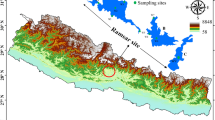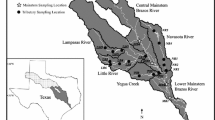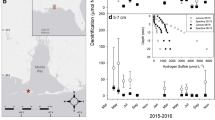Abstract
Bacteria should be excellent indicators of the early signs of degradation caused by human intervention because they have the highest surface area to volume ratio of all organisms. We determined the utility of a simple procedure that measures aerobic bacterial metabolic diversity (BIOLOG EcoPlates) as a reliable tool for assessing the effects of cattle grazing on spring ecosystems of the Bonneville Basin, Utah, USA. Marshes disturbed by cattle could be distinguished from protected marshes using EcoPlate analyses. The diversity of organic compounds used by bacteria was greater in grazed versus ungrazed marshes. A separate genetic analysis (DGGE) provided corroborating evidence. Greater metabolic diversity (EcoPlates) corresponded to greater bacterial assemblage diversity in grazed versus protected marshes. Greater plant diversity at grazed sites might account for the greater diversity of organic substrates used by bacteria in grazed sites. However, the results were not conclusive. In some marshes, a greater diversity of organic substrate use occurred where there was greater plant diversity, whereas in other marshes the diversity of organic substrates used by bacteria was lower where plant diversity was greatest. Regardless of the mechanism, aerobic bacterial metabolic diversity (EcoPlates) is a potentially valuable tool for assessing the early signs of degradation in wetland ecosystems.
Similar content being viewed by others
Literature Cited
Adamus, P. R., E. J. Clarain, R. D. Smith, and R. E. Young. 1987. Wetland evaluation technique (WET), Volume II: Methodology. U.S. Army Corps of Engineers Waterways Experiment Station, Vicksburg, MS, USA.
Amman, R. I., W. Ludwig, and K. H. Schleifer. 1995. Phylogenetic identification and in situ detection of individual microbial cells without cultivation. Microbiological Reviews 59:143–169.
Bending, G. D., C. Putland, and F. Rayns. 2000. Changes in microbial community metabolism and labile organic matter factions as early indicators of the impact of management on soil biological quality. Biology and Fertility of Soils 31:78–84.
Bochner, B. R. 1989. Breathprints at the microbial level. American Society for Microbiology News 55:536–539.
Bochner, B. R. and M. Savageau. 1977. Generalized indicator plate for genetic, metabolic and taxonomic studies with microorganisms. Applied and Environmental Microbiology 33:434–444.
Borneman, J., P. W. Skroch, K. M. O’Sullivan, J. A. Palus, N. G. Rumjanek, J. L. Jansen, J. Nienhuis, and E. W. Triplett. 1996. Molecular microbial diversity of an agricultural soil in Wisconsin. Applied and Environmental Microbiology 62:1935–1943.
Bossio, D. H. and K. M. Scow. 1995. Impact of carbon and flooding on the metabolic diversity of microbial communities in soils. Applied and Environmental Microbiology 61:4043–4050.
Brinson, M. M. 1993. A hydrogeomorphic classification for wetlands. U.S. Army Corps of Engineers Waterways Experiment Station, Vicksburg, MS, USA. Wetlands Research Program Technical Report WRP-DE-4.
Christiansen, F. W. 1951. Geology of the Canyon, House, and Confusion ranges, Millard Country, Utah. Guidebook to the Geology of Utah. University of Utah Press, Salt Lake City, USA. No. 6: 68–80.
Choi, K. H. and F. C. Dobbs. 1999. Comparison of two kinds of BIOLOG microplates (GN and ECO) in their ability to distinguish among aquatic microbial communities. Journal of Microbiological Methods 36:203–213.
Courtenay, W. R. and G. K. Meffe. 1989. Small fishes in strange places: a review of introduced Poeciliids. p. 319–331. In G. K. Meffe and F. F. Snelson, Jr. (eds.) Ecology and Evolution of Livebearing Fishes (Poeciliidae). Prentice Hall, Englewood Cliffs, NJ, USA.
Dang, H. and C. R. Lovell. 2000. Bacterial primary colonization and early succession on surfaces in marine waters as determined by amplified rRNA gene restriction analysis and sequence analysis of 16S rRNA genes. Applied and Environmental Microbiology 66:467–475.
Davis, S. M., L. H. Gunderson, W. A. Park, J. R. Richardson, and J. E. Mattson. 1994. Landscape dimension, composition, and function in a changing Everglades ecosystem. p. 419–444. In S. M. Davis and J. C. Ogden (eds.) Everglades: the Ecosystem and Its Restoration. St. Lucie Press, Deray Beach, FL, USA.
Donner, G., K. Schwarz, H. G. Hoppe, and G. Muyzer. 1996. Profiling the succession of bacterial populations in pelagic chemoclines. Archive für Hydrobiolia Special Issues in the Advancement of Limnology 48:7–14.
Duineveld, B. M., G. A. Kowalchuk, A. Keuzer, J. D. van Elsas, and J. A. van Veen. 2001. Analysis of bacterial communities in the rhizosphere of chrysanthemum via denaturing gradient gel electrophoresis of PCR-Amplified 16S rRNA as well as DNA fragments coding for 16S rRNA. Applied and Environmental Microbiology 67:172–178.
Dyer, D. P. 1978. An analysis of dissimilarity using multiple environmental variables. Ecology 59:117–125.
Ferrari, V. C. and J. T. Hollibaugh. 1999. Distribution of microbial assemblages in the Central Arctic Ocean Basin studied by PCR/DGGE: analysis of a large data set. Hydrobiologia 401:55–68.
Garland, J. L. and A. L. Mills. 1991. Classification and characterization of heterotrophic microbial communities on the basis of patterns of community-level sole-carbon-source utilization. Applied and Environmental Microbiology 57:2351–2369.
Haack, S. K., H. Garchow, M. J. Klug, and L. J. Forney. 1995. Analysis of factors affecting the accuracy, reproducibility, and interpretation of microbial community carbon source utilization patterns. Applied and Environmental Microbiology 61:1458–1468.
Hackett, C. A. and B. S. Griffiths. 1997. Statistical analysis of the time-course of BIOLOG substrate utilization. Journal of Microbiological Methods 30:63–69.
Helgen, J. C. and M. C. Gernes. 2001. Monitoring the condition of wetlands: indexes of biological integrity using invertebrates and vegetation. p. 167–185. In R. B. Rader, D. P. Batzer, and S. A. Wissinger (eds.) Bioassessment and Management of North American Freshwater Wetlands. John Wiley & Sons, New York, NY, USA.
Hershler, R. 1998. A systematic review of the Hydrobiid snails (Gastropoda: Rissooidea) of the Great Basin, Western United States. Part I. Genus Pyrgulopsis. Veliger 41:1–132.
Lemley, A. D. and R. S. King. 2000. An insect-bacteria bioindicator for assessing detrimental nutrient enrichment in wetlands. Wetlands 20:91–100.
Lindstrom, E. S. 1998. Bacterioplankton community composition in a boreal forest lake. FEMS Microbial Ecology 27:163–174.
Magurran, A. E. 1988. Ecological Diversity and Its Measurement. Princeton University Press, Princeton, NJ, USA.
McArthur, J V. 2001. Bacteria as biomonitors. p. 249–261. In R. B. Rader, D. P. Batzer, and S. A. Wissinger (eds.) Bioassessment and Management of North American Freshwater Wetlands. John Wiley & Sons, New York, NY, USA.
McArthur, J V., J. M. Aho, R. B. Rader, and G. L. Mills. 1994. Interspecific leaf interactions during decomposition in aquatic and floodplain environments. Journal of North American Benthological Society 13:57–67.
Millar, M. R., C. J. Linton, A. Cade, D. Glancy, M. Hall, and H. Jalal. 1997. Application of 16S rRNA Gene PCR to Study Bowel Flora of preterm infants with and without necrotizing enterocolitis. Journal of Clinical Microbiology 34:2506–2510.
Muyzer, G., E. C. De Waal, and A. G. Uitterlinden. 1993. Profiling of complex microbial populations by denaturing gradient gel electrophoresis analysis of polymerase chain reaction-amplifed genes coding for 16S rRNA. Applied and Environmental Microbiology 59:695–700.
Rader, R. B. 1999. the Florida Everglades: natural variability, invertebrate diversity, and foodweb stability. p. 25–54. In D. P. Batzer, R. B. Rader, and S. A. Wissinger (eds.) Invertebrates in Freshwater Wetlands of North America: Ecology and Management, John Wiley & Sons, New York, NY, USA.
Rader, R. B., D. P. Batzer, and S. A. Wissinger. 2001. Bioassessment and Management of North American Freshwater Wetlands. John Wiley & Sons, New York, NY, USA.
Roling, W. F. M., B. M. van Breukelen, M. Braster, M. T. Goeltom, J. Groen, and H. W. van Verseveld. 2000. Analysis of microbial communities in a landfill leachate polluted aquifer using a new method for anaerobic physiological profiling and 16S rDNA based fingerprinting. Microbial Ecology 40:177–188.
Rolleke, S., G. Muyzer, C. Wawer, G. Wanner, and W. Lubitz. 1996. Identification of bacteria in a biodegraded wall painting by denaturing gradient gel electrophoresis of PCR-amplified gene fragments coding for 16S rRNA. Applied and Environmental Microbiology 62:2059–2065.
Sievert, S. M., T. Brinkhoff, G. Muyzer, W. Ziebis, and J. Kuever. 1999. Spatial heterogeneity of bacterial populations along an environmental gradient at a shallow submarine hydrothermal vent near Milos Island (Greece). Applied Environmental Microbiology 65:3834–3842.
Smalla, K., U. Wachtendorf, H. Heuer, W. Liu, and L. Forney. 1998. Analysis of BIOLOG GN substrate utilization patterns by microbial communities. Applied Environmental Microbiology 64:1220–1225.
Teske, A., C. Wawer, G. Muyzer, and N. B. Ramsing. 1996. Distribution of sulfate-reducing bacteria in a stratified fjord as evaluated by most-probable-number counts and denaturing gradient gel electrophoresis of PCR-amplified ribosomal DNA fragments. Applied and Environmental Microbiology 62:1405–1415.
van Hannen, E. J., G. Zwart, M. P. van Agterveld, H. J. Gons, J. Ebert, and H. J. Laanbroek. 1999. Changes in bacterial and eukaryotic community structure after mass lysis of filamentous cyanobacteria associated with viruses. Applied Environmental Microbiology 65:795–801.
Vymazal, J., C. B. Craft, and C. J. Richsardson. 1994. Periphyton response to nitrogen and phosphorus additions in the Florida Everglades. Algological Studies 73:75–97.
Weber, S., S. Stubner, and R. Conrad. 2001. Bacterial populations colonizing and degrading rice straw in anoxic paddy soil. Applied and Environmental Microbiology 67:1318–1327.
Webster, J. R. and E. F. Benfield. 1986. Vascular plant breakdown in freshwater ecosystems. Annual Review of Ecology and Systematics 17:567–594.
Wilcox, D. A. 1995. Wetland and aquatic macrophytes as indicators of anthropogenic hydrologic disturbance. Natural Areas Journal 15:240–258.
Winding, A. 1994. Fingerprinting bacterial soil communities using BIOLOG microtitre plates. p. 85–94. In K. Ritz, J. Dighton, and K. E. Giller (ed.) Beyond the Biomass: Compositional and Functional Analysis of Soil Microbial Communities. John Wiley & Sons Ltd., Chichester, UK.
Wunsche, L., L. Bruggemann, and W. Babel. 1995. Determination of substrate utilization patterns of soil microbial communities: an approach to assess population changes after hydrocarbon pollution. FEMS Microbiology Ecology 17:295–306.
Author information
Authors and Affiliations
Rights and permissions
About this article
Cite this article
Merkley, M., Rader, R.B., McArthur, J.V. et al. Bacteria as bioindicators in wetlands: Bioassessment in the Bonneville Basin of Utah, USA. Wetlands 24, 600–607 (2004). https://doi.org/10.1672/0277-5212(2004)024[0600:BABIWB]2.0.CO;2
Received:
Revised:
Accepted:
Issue Date:
DOI: https://doi.org/10.1672/0277-5212(2004)024[0600:BABIWB]2.0.CO;2




